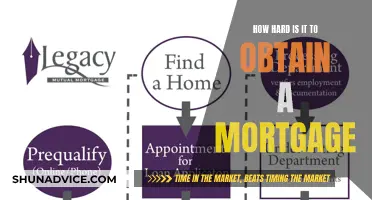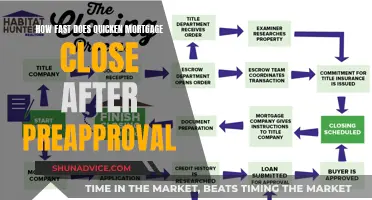
Foreclosure is a scary word for any homeowner, but it's important to know your rights and the steps you can take to avoid it. In California, the foreclosure process can vary depending on the lender and the situation, but generally, it begins when a homeowner misses their first mortgage payment. This is considered a breach of the mortgage agreement, and while lenders may be lenient with occasional missed payments, continued failure to pay can lead to serious consequences. Understanding the timeline and your options is crucial to navigating this challenging situation.
| Characteristics | Values |
|---|---|
| First day of the foreclosure process | The first day a homeowner falls behind on their mortgage payment |
| Grace period | 15 days |
| Mortgage considered officially in default | 90 days |
| Lender to contact borrower | 30 days before filing a notice of default |
| Notice of default | Filed with a court, informs the borrower that they are in default |
| Demand letter | After the third missed payment |
| Time to bring mortgage payments up to date | 30 days |
| Notice of trustee's sale | 21 days before the sale date |
| Foreclosure process timeline | 200 days |
| Time to apply for mortgage relief programs | Before the trustee's sale |
| Eviction notice | 5 days |
What You'll Learn
- The foreclosure process in California begins with the first missed mortgage payment
- Lenders must contact the borrower by phone or in person 30 days before filing a notice of default
- The borrower has 30 days to bring their mortgage payments up to date after receiving a demand letter
- The foreclosure process usually takes about 200 days or more, with the first missed payment date counting as day one
- The lender must inform the borrower of the amount required to stop the foreclosure and the due date

The foreclosure process in California begins with the first missed mortgage payment
During the pre-foreclosure stage, lenders are required by California law to contact the borrower by phone or in person at least 30 days before filing a notice of default. This is an attempt to discuss the borrower's financial situation and explore options to remedy it. It is important for borrowers to communicate clearly with their lender and ask about possible alternatives. This is also an opportunity to gain a better understanding of the foreclosure process and the potential consequences.
After the first missed payment, the lender can charge a late fee, typically ranging from 4% to 6% of the payment amount. If the borrower fails to make the second payment, they are considered in default, and the loan servicer may intensify their collection efforts. The lender may impose additional late fees and report the borrower to credit bureaus, negatively impacting their credit score.
As the foreclosure process unfolds, the lender's attorneys will get involved, and the borrower will start incurring legal fees. After the fourth missed payment, the lender's attorneys may proceed with a foreclosure sale, adhering to state and local laws. The borrower will receive a notice of the sale, providing them with information about the auction of their property. This notice must be given at least 21 days before the sale date, allowing a final opportunity to resolve the mortgage issues.
Comparing Mortgages: How Does Yours Stack Up?
You may want to see also

Lenders must contact the borrower by phone or in person 30 days before filing a notice of default
In California, the foreclosure process begins with the first missed mortgage payment. Lenders will typically begin foreclosure three to six months after the first missed payment. However, before filing a notice of default, California law requires lenders to contact borrowers by phone or in person 30 days in advance. This is the lender's first attempt to help remedy the situation and discuss the borrower's financial circumstances and options for moving forward. It is important for borrowers to be transparent about their situation and ask about potential alternatives. This is also an opportunity for borrowers to gain clarity on the California foreclosure process and understand their options to prevent losing their homes.
During this 30-day period, lenders are required to inform borrowers of the amount required to halt the foreclosure process and the associated deadline. Borrowers have approximately a month to rectify their payments before the situation escalates and becomes more serious and official. Generally, mortgage payments are considered officially in default on day 90, after the third missed payment. At this point, a notice of default is filed with the court, and the borrower is informed that they are in default.
It is worth noting that the timeline for the foreclosure process can vary depending on factors such as the lender's policies and the state of the local housing market. Some lenders may be more lenient with missed payments, especially if they have a portfolio of low-risk loans. On the other hand, lenders with a portfolio of high-risk loans may initiate foreclosure proceedings more rapidly. Additionally, if there are multiple pending foreclosures in the same neighbourhood or region, the process may be prolonged due to backlogs in local housing authorities and courts.
To summarise, while the foreclosure process in California typically follows a standard timeline, there are factors that can influence its progression. It is important for borrowers to maintain open communication with their lenders and seek appropriate assistance to resolve their financial difficulties.
Mortgage-Backed Securities: Boosting Economy Through Homeownership
You may want to see also

The borrower has 30 days to bring their mortgage payments up to date after receiving a demand letter
Foreclosure is a legal process in California that allows a lender to force the sale of a home or property to cover a debt, such as a mortgage loan. The process typically begins when a borrower misses their mortgage payments, and the specific timeline and procedures can vary depending on the lender and the state.
In California, the foreclosure process generally starts after a borrower misses a certain number of payments, often three to four consecutive monthly payments. However, some lenders may initiate foreclosure proceedings after just two missed payments, especially if they have a portfolio of high-risk loans. On the other hand, if a lender has a large portfolio of low-risk loans, they may be more lenient and might not pursue foreclosure unless there are continuous missed payments.
During the pre-foreclosure stage, the lender will typically send letters and make phone calls to the borrower, notifying them of their missed payments and urging them to bring their account up to date. California law requires the lender to contact the borrower by phone or in person at least 30 days before filing a notice of default to discuss their financial situation and explore potential remedies. This is an important opportunity for the borrower to communicate their circumstances and ask about possible options, such as forbearance or loan modification.
Once a borrower has missed their third payment, the lender can send a demand letter stating the total amount owed. At this point, the borrower has 30 days to bring their mortgage payments up to date. This is a critical window of opportunity to resolve the issue and prevent the foreclosure process from advancing further. If the borrower fails to take action within this timeframe, the lender's attorneys may proceed with the next steps in the foreclosure process, including scheduling a foreclosure sale.
It's important to note that missing mortgage payments can have significant consequences. Late fees, additional interest, and negative impacts on credit scores can all contribute to a challenging financial situation. Therefore, borrowers who anticipate missing a payment or falling behind should proactively contact their mortgage company to discuss loss mitigation options and explore alternatives to foreclosure.
Money Flows: Understanding Mortgage Money Trails
You may want to see also

The foreclosure process usually takes about 200 days or more, with the first missed payment date counting as day one
Foreclosure is a slow but unnerving process, with a lot of chances to stop it along the way. The first missed payment date counts as day one of the foreclosure process, which usually takes about 200 days or more. This timeline includes the pre-foreclosure stage, which is the process that leads up to the final foreclosure sale date.
During the first 30 days of delinquency, your lender must attempt to contact you by phone or in person to discuss your financial situation and options for improving it. This is the lender's first attempt to help find a remedy for your situation, so it is important to communicate and explain your circumstances clearly. You may be able to work out a forbearance plan with your mortgage company, which would allow you to temporarily pause making mortgage payments, or apply for a loan modification, which would set new conditions for the loan that are more affordable for you. During this time, you will likely receive letters from your lender containing warnings that you need to bring your account up to date.
After 90 days, your mortgage payments are considered officially in default. At this point, you will have about a month to set things right before the situation becomes more serious and official. You will receive a notice of default, which is filed with a court and informs you that you are in default. This notice usually includes information about the borrower and lender, as well as the next steps the lender may take. After your third missed payment, your lender can send a demand letter stating how much you owe and giving you 30 days to bring your mortgage payments up to date.
After about 180 days, the lender will record a notice of trustee sale, letting you know that your house will be put up for auction. This notice must be given at least 21 days before the sale date, allowing a final window to resolve mortgage issues. Until the actual trustee's sale takes place, California law provides homeowners with certain rights and options to stop the foreclosure. However, if you are unable to prevent the sale, the new owner of the home only needs to give you a 3-day notice to move. If you do not move, they can begin the eviction process by filing an Unlawful Detainer lawsuit against you in court. If you lose in court, a 5-day eviction notice will be posted on your door, after which the Sheriff will return to force you to move out.
Avoiding Foreclosure: Understanding Vanderbilt Mortgage's Grace Period
You may want to see also

The lender must inform the borrower of the amount required to stop the foreclosure and the due date
Foreclosure is a legal process in California that allows a lender to force the sale of a property to cover a debt, such as a mortgage loan. The first missed mortgage payment is considered the first day of the foreclosure process. Most lenders offer a grace period, but late fees and additional interest can quickly snowball. Generally, a mortgage is considered officially in default on day 90, at which point the lender will file a notice of default (NOD). This NOD letter informs the borrower of the lender's intention to foreclose and the amount required to stop the foreclosure, along with the due date. California law requires lenders to contact borrowers 30 days before filing the NOD to discuss their financial situation and options. This is an opportunity for borrowers to communicate their circumstances and explore potential remedies, such as forbearance or loan modification.
The NOD letter is a crucial step in the foreclosure process, as it outlines the specific actions borrowers must take to avoid foreclosure. It includes the amount required to stop the foreclosure and the deadline by which this amount must be paid. This amount may include late fees, additional interest, and other charges accrued during the delinquency. It is important to note that the lender must provide accurate and clear information about the amount due and the deadline to stop the foreclosure.
The notice of default is typically filed after 90 days of missed payments, and it serves as a formal warning to the borrower that the lender intends to initiate foreclosure proceedings if the debt is not resolved. The NOD letter is usually sent via mail or delivered in person, and it marks a critical point in the foreclosure process. It is important for borrowers to take this notice seriously and respond promptly to avoid further complications. The NOD letter also triggers a series of legal requirements and protections for borrowers under California law.
After receiving the NOD letter, borrowers have a limited amount of time to take corrective action. The exact timeframe can vary depending on local laws and the specific terms of the mortgage agreement. However, it is generally recommended to act as quickly as possible to increase the chances of resolving the issue. During this period, borrowers may have the opportunity to negotiate with the lender, bring their account up to date, or explore alternative solutions such as loan modifications or forbearance programs.
It is important to note that the lender is required to provide accurate and up-to-date information about the borrower's rights and options to avoid foreclosure. They must also ensure that the borrower understands the consequences of failing to meet the requirements outlined in the NOD letter. If the borrower fails to take the necessary actions by the specified due date, the lender may proceed with the foreclosure process, which could ultimately lead to the loss of the property. Therefore, it is crucial for borrowers to take proactive measures and seek assistance if needed to resolve the issue promptly.
Adding Someone to Your Mortgage: A Simple Process?
You may want to see also
Frequently asked questions
The California foreclosure process timeline generally takes about 200 days. The first missed payment date qualifies as day one.
You can usually be delinquent on your mortgage payment by 120 days before the foreclosure process begins. This means that you can miss no more than three consecutive monthly mortgage payments before you're at risk of foreclosure. However, this can vary based on other factors, including your lender's particular policies and the state of the housing market in your area at the time.
Most lenders extend homeowners a grace period that allows them extra time to make the mortgage payment – along with paying a late fee – before moving on to the next steps in the foreclosure process. Generally, mortgage payments are considered officially in default on day 90.
If you know you are going to miss a mortgage payment, reach out to your mortgage company proactively to discuss loss mitigation options. You may be able to work out a forbearance plan with your mortgage company, which would allow you to temporarily pause making mortgage payments.







